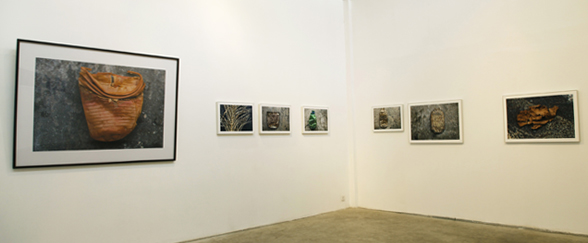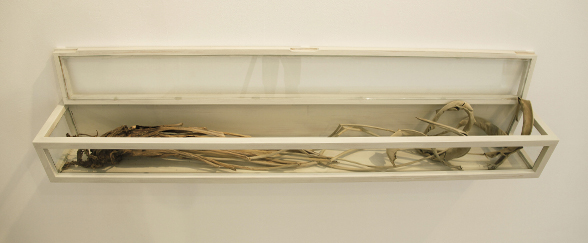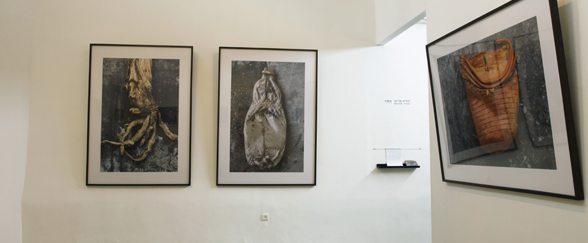"Restoration", The Artists House, Tel-Aviv 2011
Hanging from a nail
A cricket"
How perceptible is the picture captured in this Haiku by Japanese poet Matsuo Basho (1644-1694) and how simple and direct the description that guides the reader’s gaze. Judith Schreiber perceives the world in a similar manner. Her eye captures objects that completed their function and now lay abandoned in the field: Plastic soft drink bottles, tin cans, dry, uprooted plants. All are crumpled, empty, devoid of aura. Schreiber gathers them and gives them a place. Viewers, like a Haiku’s readers, are invited to look, ponder and recall, without judging the experience of the object before them. Unlike the Haiku, that describes a living and present experience, Schreiber’s photographs display “dead,” superfluous refuse. But their concreteness, minimalism and sharpness resuscitate the crumpled metal, cracked plastic and dry-veined leaf, arousing ecological ruminations concerning functionality, the cycle of life, the process of dying and restoration to nature.
Aura. Photographs of rusty cans and dry leaves appear to conform to the Japanese æsthetic definition of wabi-sabi as “quality whose time has passed; old age; solitude; the quality of a worn, obsolescent object; something in which a life story is evident and is still going on; rust; verdigris; the quality of rustiness. It would be crude to state that one may discern a life story or quality in the plastic cup and bottle, in contrast to the cans and leaf. Unlike metal or plant life, plastic is a material without a history. It never purports to have an aura but rather constitutes an industrial material that lacks an ethos. In the photographs, however, the plastic containers, alongside the leaf and the cans, are reilluminated through a new artistic look at the obsolete.4 Technological evolution appears to be taking its last glance, departing from the old object that is to be embodied as an image. The more that technology invents and innovates, the more the masses seek to get rid of the old. All you have to do is look down – in the city, along the street, at the side of the road, at camping grounds and picnic areas – wherever you look, there are metal and plastic containers crushed under the wheels of moving vehicles. Yet from the moment they take shape as an artistic image, they are magnified beyond their original dimensions and displayed as towering mummies.
Restoration. When metal rusts and crumbles, it eventually disappears (over several decades).5 Rust, iron oxide, returns to become an integral part of the earth. Oxygen and moisture accelerate the deterioration of materials.Culture delays their restoration. Objects we abandon after they lose their functionality appear to start a long new life cycle as pollution-causing refuse. Much energy is invested in their manufacture, but on their conversion to refuse – all these energies are ultimately lost.
Being (Dasein). Material has a tendency to persevere with minimal energy. Metal, at minimum energy, is in the state of rust. The Haiku presents things as they are, in an authentic manner, with the proper energy, arousing the reader-beholderlistener’s connection with the present materials as they are. It allows objects to be perceived here and now, in their own way, not as instruments.6 The objects in Judith’s photographs also tend to exist with minimum energy. They are placed in earth just like the photographer-poet-viewer-poem reader-we who are reading here. And just as there are objects placed in earth, for which desire has been lost, so too, one day, we will be neglected, lost and forgotten.
In one single photograph at the exhibition, the viewer’s gaze rises and focuses on a dark landscape of earth and rocks, to sunlight and fleeting shadow in that place and of that time.
"Quietness - Sinking into the rocks A cicada’s cry"Basho
Outside the frame, there probably are crumpled, auraless objects and a cannon fires, preparing for war.
Moran Shoub curator



